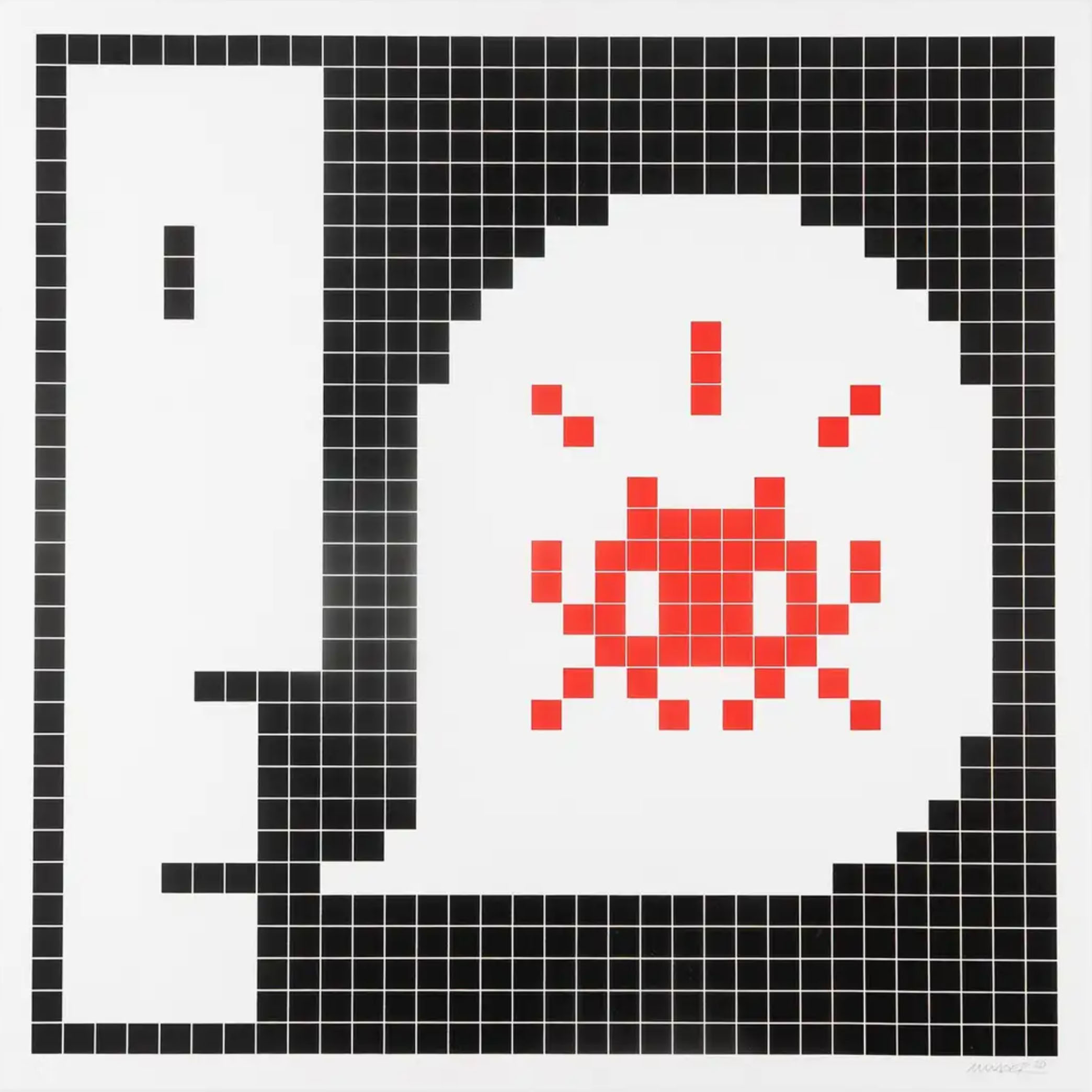PangeaSeed Foundation, the international marine conservation organisation, collaborated with HarborArts and produced in partnership with honorary conservation partner, the New England Aquarium, and hosted the street art festival Sea Walls: Murals for Oceans in Boston, USA.
The festival took place 19th -25th of July 2021. Twenty-One murals were painted to educate people about the oceans’ critical issues and inspire the environmental stewardship of our most important natural resources. A team of local, regional and international artists came together to paint for a purpose and bring our oceans to the streets.
Once a chain of islands and marshland, East Boston is one of Boston’s most vulnerable communities to the impacts of flooding, increased heat, and coastal and industrial overdevelopment. With Eastie’s vibrant tapestry of cultures, history, and environmental richness, it was determined by a group of dedicated residents that it would be an ideal host location for a Sea Walls: Artists for Oceans project.
In addition to the murals, Sea Walls Boston partnered with Boston Harbor Now and Eastie Week to include a series of activities and programming for the community to get involved. Also in collaboration with Bow Seat Ocean Awareness Programs, programs were developed with Boston Public Schools, like the Donald McKay School in East Boston, to include youth in the conversation to protect our blue planet.
Artists invited included Dragon76 (Japan), Shepard Fairey (USA), Kai Kaulukukui (USA), Taylor Reinhold (USA), Marka27 (USA), Nneka Jones (Trinidad and Tobago), Felipe Ortiz (USA | Colombia), Sabrina Dorsainvil, (USA), Lauren YS (USA), Sophy Tuttle (USA), Taj Francis (Jamaica), Tallboy (USA), It’s a Living (Mexico), Beau Stanton (USA) and Josie Morway (USA).
Dive in ..
Dragon76- Protect
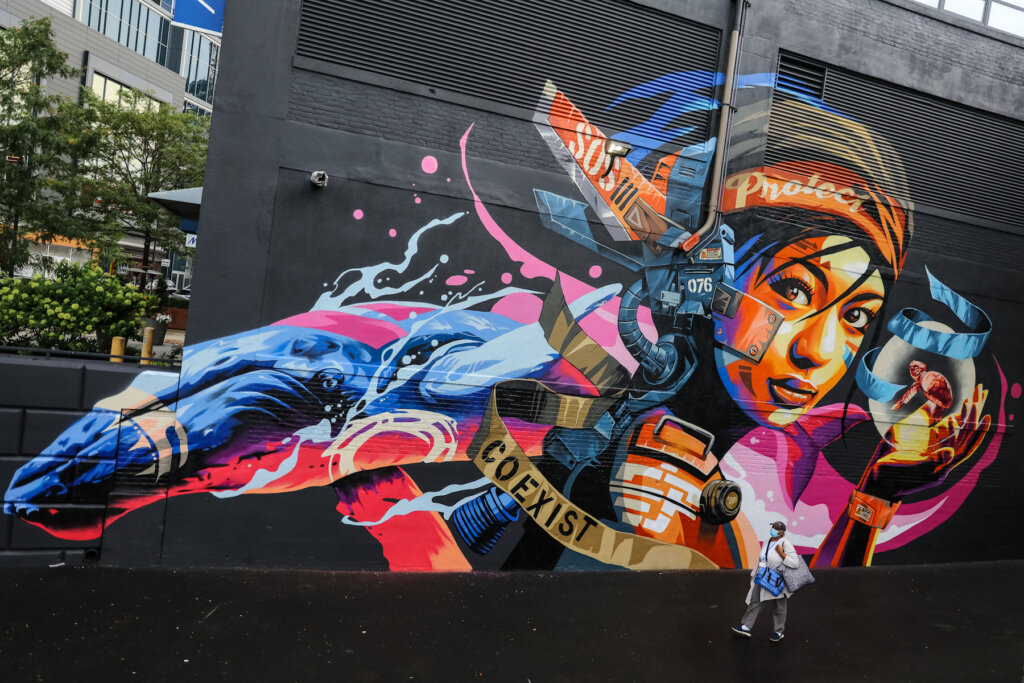
“The state of the marine environment and the life that calls it home has declined at humanity’s hands, so I created this image with the preciousness of life in mind to convey the message that protecting and restoring the health of our ocean also lies in our hands.”
Dragon76
Shepard Fairey -A Vital and Vibrant Ocean for All
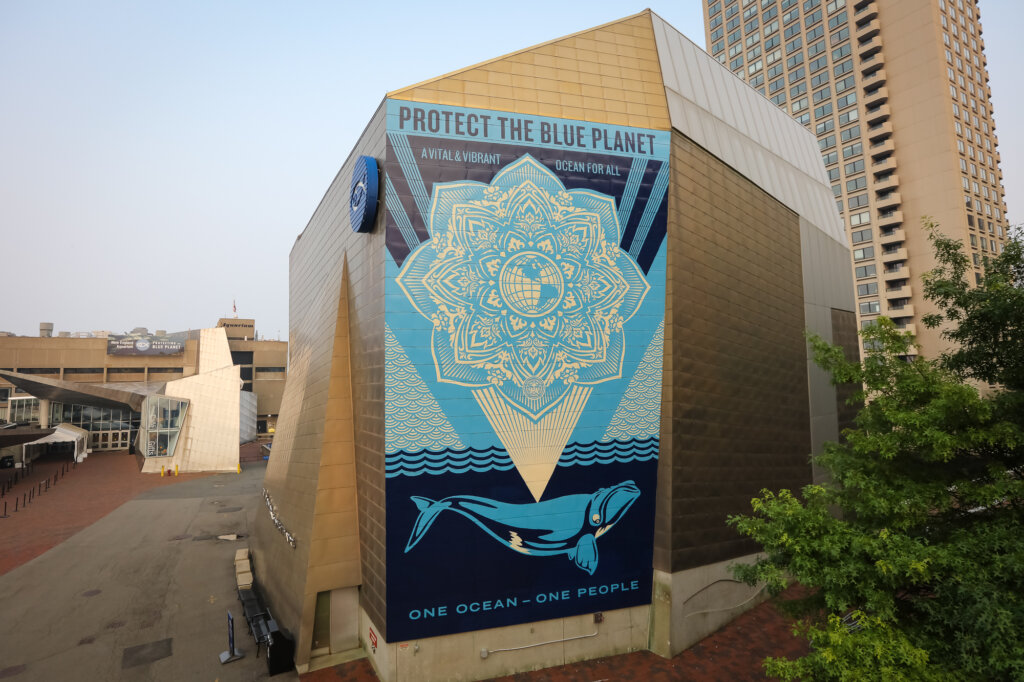
“‘A Vital and Vibrant Ocean For All’ features a critically endangered North Atlantic right whale emanating a mandala with the earth as its focal point. In several cultures, the mandala represents harmony, unity, and wholeness, all of which are important concepts when considering the interconnected nature of the planet’s ecosystems, people, and species.
The mandala includes floral ornaments symbolizing harmony in bloom, but also flames as a reminder of the perils of global warming. The ‘One Ocean—One People’ and ‘Protect the Blue Planet’ text within the mural and the blue color palette emphasize the crucial connection between healthy oceans and a healthy planet.”
Shepard Fairey
Kai Kaulukukui, Taylor Reinhold- Solo hay un océano /There is only one ocean
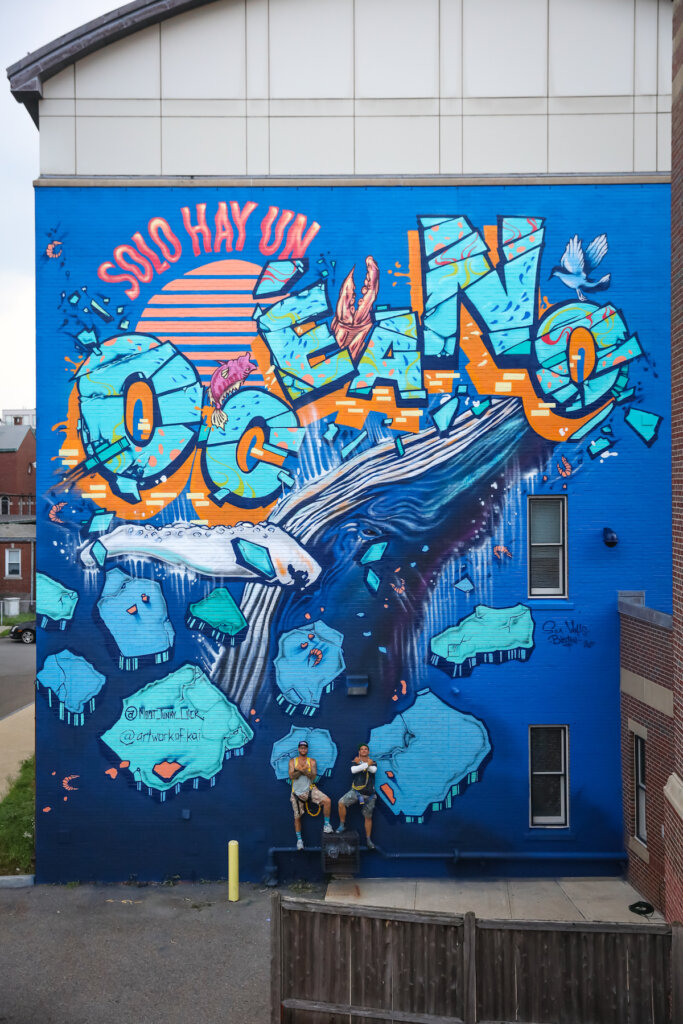
“The statement, ‘There is Only One Ocean’, is number one on the UN’s Seven Principles of Ocean Literacy list, and is a powerful reminder that we’re all connected by our seas. For me growing up in Hawaii and spending countless hours in the ocean and on the shores of two islands there was one constant: besides my colorful reef fish buddies, every beach had plastics and other trash washed ashore. I remember thinking as a young child, ‘how are there pieces of plastic with so many different types of writing pressed into them, here in Hawaii?’ Then being taught about tides and the forces at sea that can disperse the world’s garbage into the Pacific Ocean and it all made sense to me; there is in fact only one ocean and it connects us all.
We chose to focus on the saying ‘There is only one ocean’ in its literal translation by using an old school block letter graffiti typography. After spending a few days in the neighborhood and meeting local children who attend the school we were painting, we decided to translate the message into Spanish. There is a connection a person can feel when viewing art and we hope this message will reach the next generation of ocean stewards.”
Kai Kaulukukui
Espíritu del Mar by Marka27
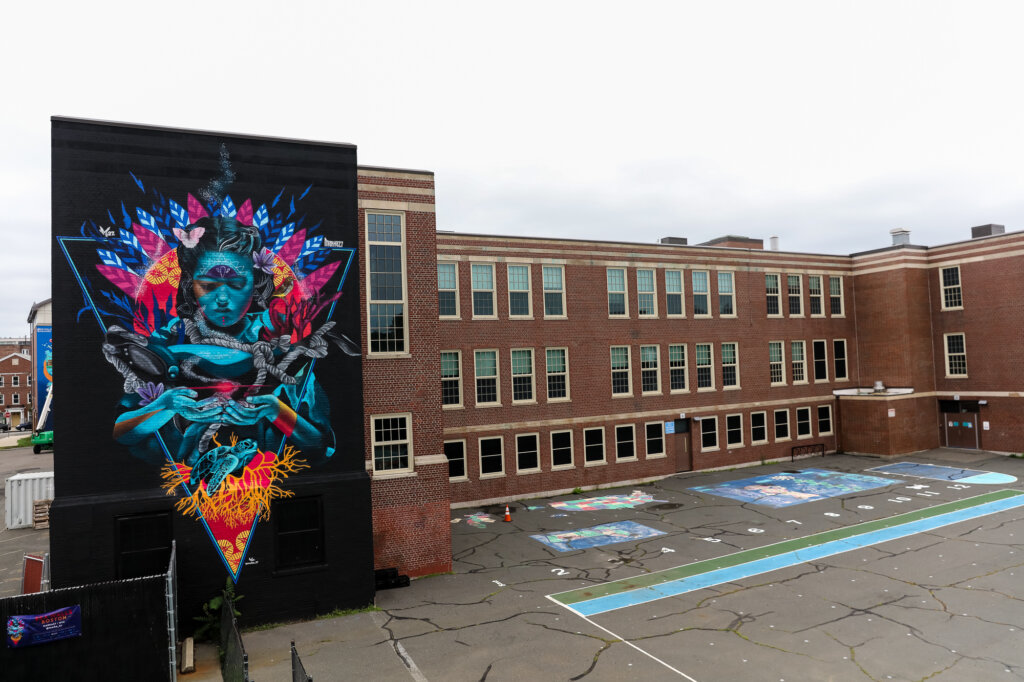
“My mural is about connecting youth with ocean life and all living creatures. The young girl in this mural is holding an endangered whale affected by climate change and trapped in fishing nets. The young girl is looking down with empathy and connecting spiritually with this amazing creature. I wanted the children who attend the McKay school to see themselves in this mural by painting an indigenous girl but I also wanted to show the youth that we must treat our planet and all life with respect and empathy. We are all connected and are all one.”
Marka27
Nneka Jones – Intersectional Environmentalism: Generational Uproot
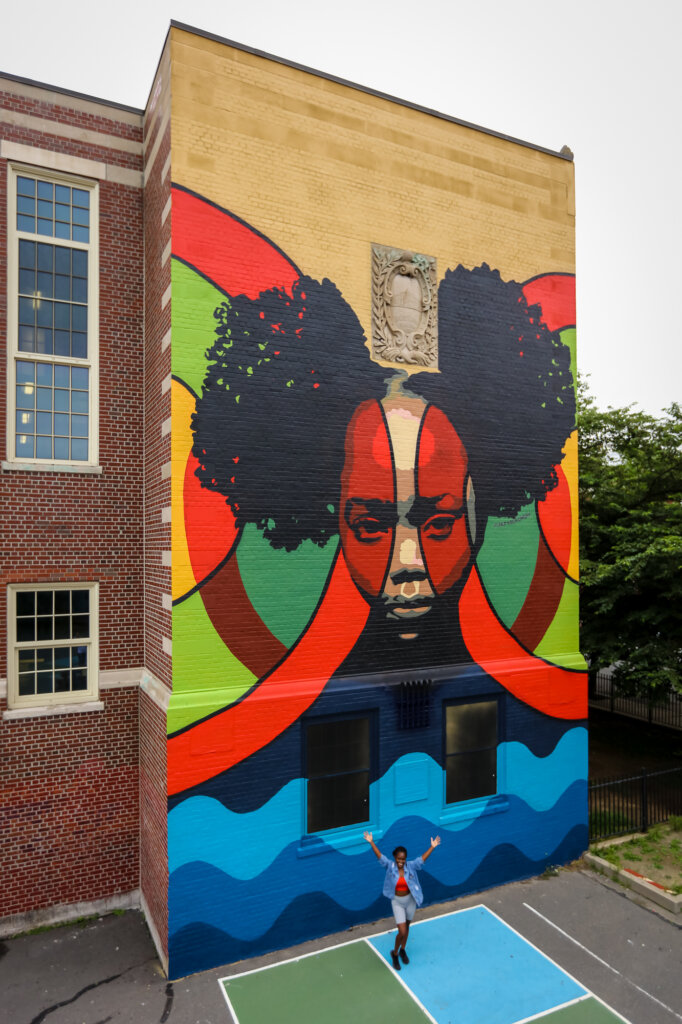
“The protection of people and the preservation of the planet are two topics dealing with social and environmental justice. For many reasons, one often views them independently of each other, ignoring the fact that one directly affects the other. ‘Intersectional Environmentalism: Generational Uproot’ is a 40 ft x 25 ft mural located at the Donald McKay K-8 School in Boston, Massachusetts with thought-provoking symbolism that represents a more inclusive version of environmentalism and activism. Using bold, graphic imagery almost like an oversized stamp—this hand-painted mural serves as a reminder and warning of the extent of damage and potential dangers affecting future generations of marginalized communities.Viewed from the bottom up, hues of blues encompass large waves that are stacked beyond the windows of the building, giving the impression that water is filling the room. This represents the idea of rising sea levels due to the effects of climate change, a huge problem for Boston today; spilling over into neighborhoods and affecting the futures of black and brown children. The bold portrait of a young girl and her iconic puffs is layered with colors and overlapping circles for a metaphoric play on the idea of intersections but can also be viewed as a split/ divided target symbol, dismantling this cycle of injustice on vulnerable communities. My hope is that viewers can not only appreciate the beauty of the young girl and fall in love with the transparencies and overlapping colors, but also spend enough time observing and analyzing the mural that they can leave with a deeper understanding.”
Nneka Jones
Felipe Ortiz-Aquatic Dimensions
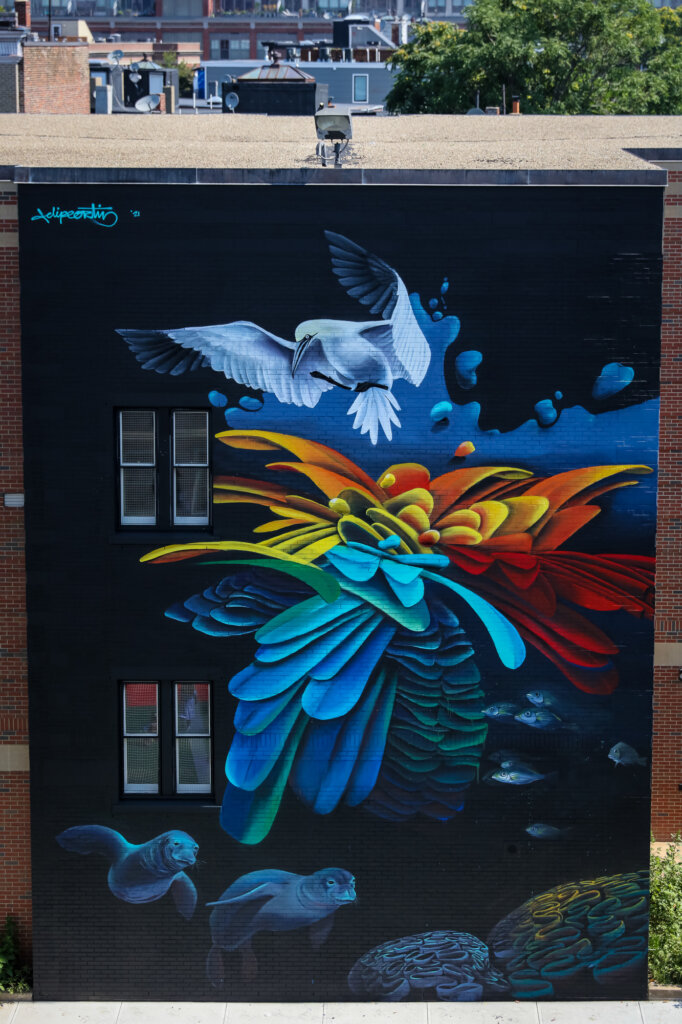
“As a Massachusetts and coastal resident, it is an honor to represent our ocean through my artistic interpretation in East Boston. As a Colombian, it’s inspiring to connect with such a vibrant and diverse Latino community. I’ve seen East Boston go through a rapid change in infrastructure, and consequently, a social adaptation in its neighborhoods. While change is inevitable and can bring the best to its communities, one thing that is severely affected by this change is our ocean. Coastal overdevelopment raises a questionable factor in the balance of our local ecosystem, as our marshes and waterways are crucial for the sustainability of our local biodiversity. Some of our surrounding wildlife is resilient enough to adapt to the ever-changing human habitat, but we should at least question our relationship and respect to our oceans, and what it means to protect the beauty of our surrounding natural seascape. I invite the viewer to not only enjoy the subject matter as the passing beauty our oceans can offer, but to also engage in the dimensionality of the composition, and further engage in the continuous effort to conserve and protect nature around us.”
Felipe Ortiz
Sabrina Dorsainvil-Sea Keepers // Guardianes del mar
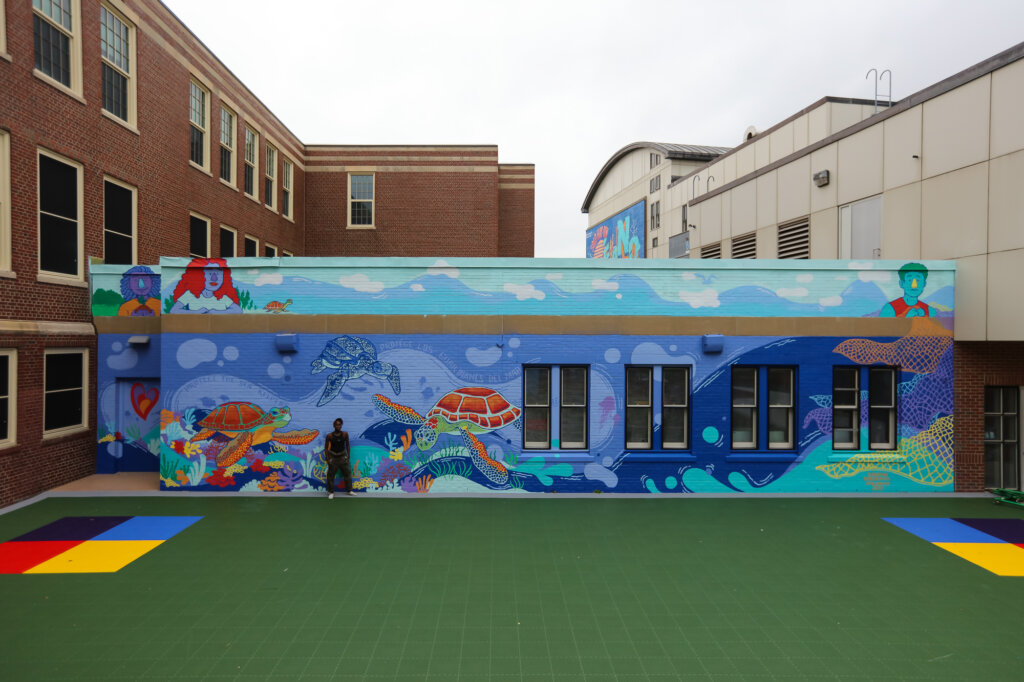
“The ocean flows with a delicate balance. The sea creatures that call it home depend on its health and each other to thrive. The Leatherback sea turtle helps corral the jellyfish population with every meal. They travel far and wide across the open ocean while providing protection for smaller creatures. Green sea turtles maintain the seabed by eating seagrass and algae. The Atlantic Hawksbill serves as a reef keeper, ensuring other animals can access healthy coral. Each unique role and their everyday actions matter. Some of the biggest risks to sea turtles are dangerous fishing gear, habitat loss, pollution, excessive egg collection, coastal development, and climate change. These sea turtles need protection and we need them to continue their role in the ocean’s wondrous equation. Whether we realize it or not, humans are part of this delicate balance, and our homes and lives depend on it too. This piece is a joyful celebration of sea turtles as guardians of the sea. It calls upon all of us to see ourselves as fellow keepers of this vital marine ecosystem. The ocean connects us. We are all sea keepers.”
Sabrina Dorsainvil
Lauren YS- Plastic Pandora
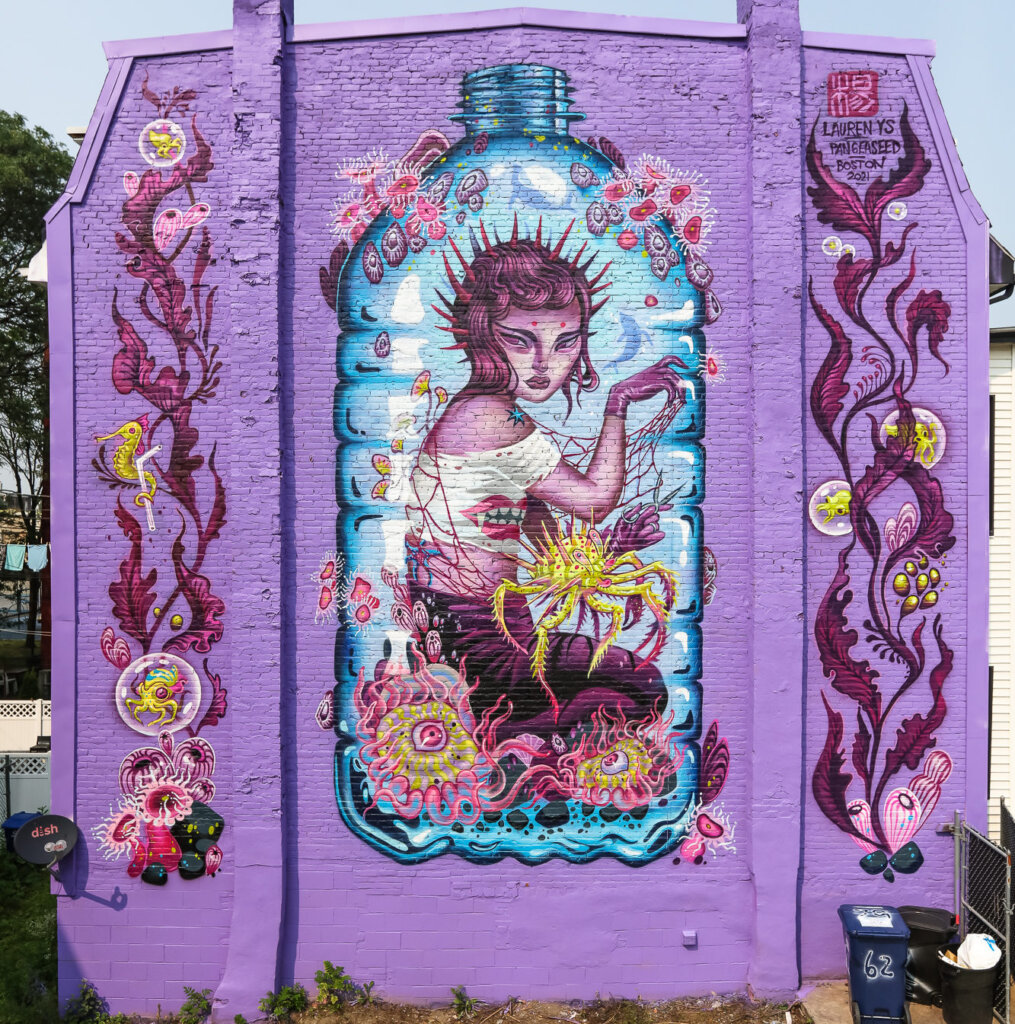
“A call to action designed around the way plastic waste harms communities and sea life across New England. ‘Pandora’ references the Greek myth of the box opened to reveal all the evil in the world, paralleling the expediency of plastic’s detrimental effect on the air, water, and intersectionally disadvantaged communities of the world. Plastic accounts for 60-80% of marine garbage, and in high-density areas, reaches up to 95%. The reality is that every piece of plastic that has ever been made still exists in one form or another. Even when burned, it breaks down into microscopic, toxic particles. Made from oil, plastic is not a material that our planet can digest. While beach cleanups are great to get people involved in hands-on activities to remove waste that has already washed ashore, unless we close the tap on plastic production, invest in the development of innovative alternatives, and hold trashy corporations accountable to their actions, cleanups are of little or no avail. The microplastics cascade into Boston Harbor from stormwater and, in the case of fabrics, from the washing machines that feed into municipal sewer treatment plants that eventually dump into the harbor. Adult seabirds inadvertently feed small pieces of plastic to their chicks, often causing them to die when their stomachs become filled with petroleum byproducts. As plastic breaks down into smaller fragments (microplastics that may contain toxic chemicals as part of their original plastic material or adsorbed environmental contaminants such as PCBs), fish and shellfish become increasingly vulnerable to the toxins these polluted particles collect. These bits of plastic are of a size similar to plankton. Oysters, clams, and mussels in the harbor filter seawater to consume tiny bits of food, and thus wind up collecting the microplastics too, which then begin being passed through the food chain.”
Lauren YS
Sophy Tuttle – FEAR
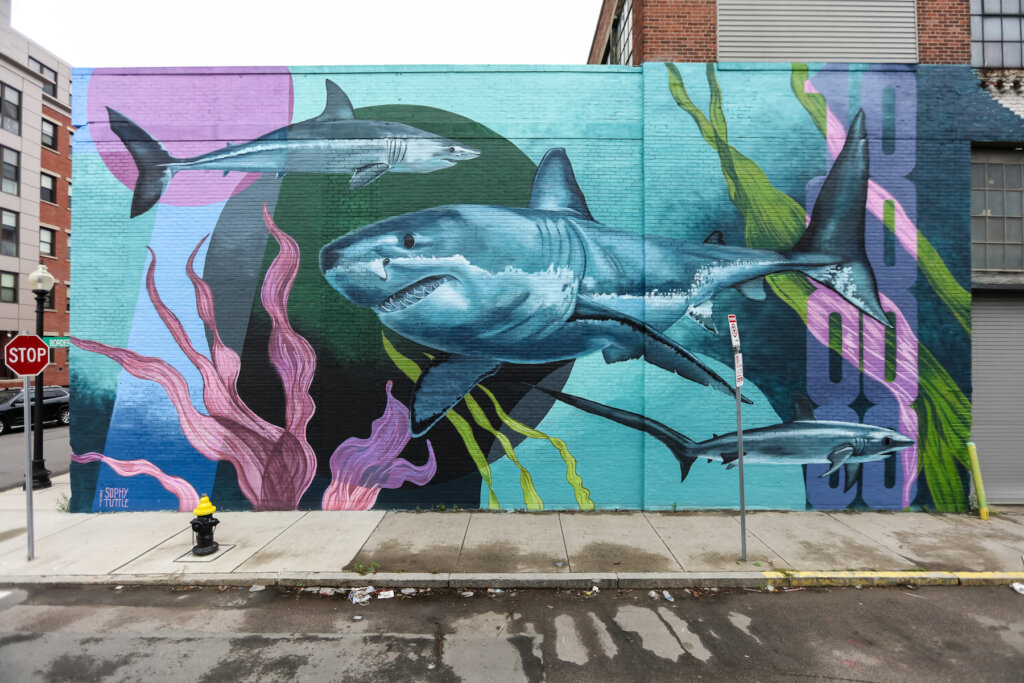
“Every year, an average of seven people die from interactions with sharks in the ocean. When I tell people this fact they second guess me, make me look it up on my phone right in front of them, or tell me I must mean every day, not every year. The truth is that although these deaths are tragic for the families that experience them, you stand more of a chance of being crushed to death by a vending machine than dying from a shark attack in any given year. So why are we so afraid of sharks? In my research for this mural I came across many possible reasons, but to me the most intriguing is the loss of control we feel when we enter into the vast, open ocean and are confronted with its almost incomprehensible depth and mystery. The idea that a formidable predator like a shark could take us by surprise fills us with a sense of dread even if we know that statistically, this is completely irrational. The real irony here comes when I mention a second fact. Over 100 million sharks die from human interactions globally every year. Our desperation for control over oceans, markets, medicines, the food chain, the past, the future, and everything in between, means we strive to dominate all other species on Earth, most often through violence justified with terms such as ‘the economy’ or ‘progress.’ But the violence we visit on other species is only a temporary form of control. As we continue to slaughter our fellow creatures with abandon, our ability to control the future slips through our fingers in a directly-correlating negative feedback loop. Until we can learn to honor our ideals of bounty and regeneration above those of capitalistic extraction and control, we will continue this downward spiral. The more we try to control, the more chaotic our world systems will get. However, if we can learn to value balance and reciprocal generosity, I have great hope that we can create a better outcome for future generations of all creatures.”
Sophy Tuttle
Taj Francis -Guiding Giants
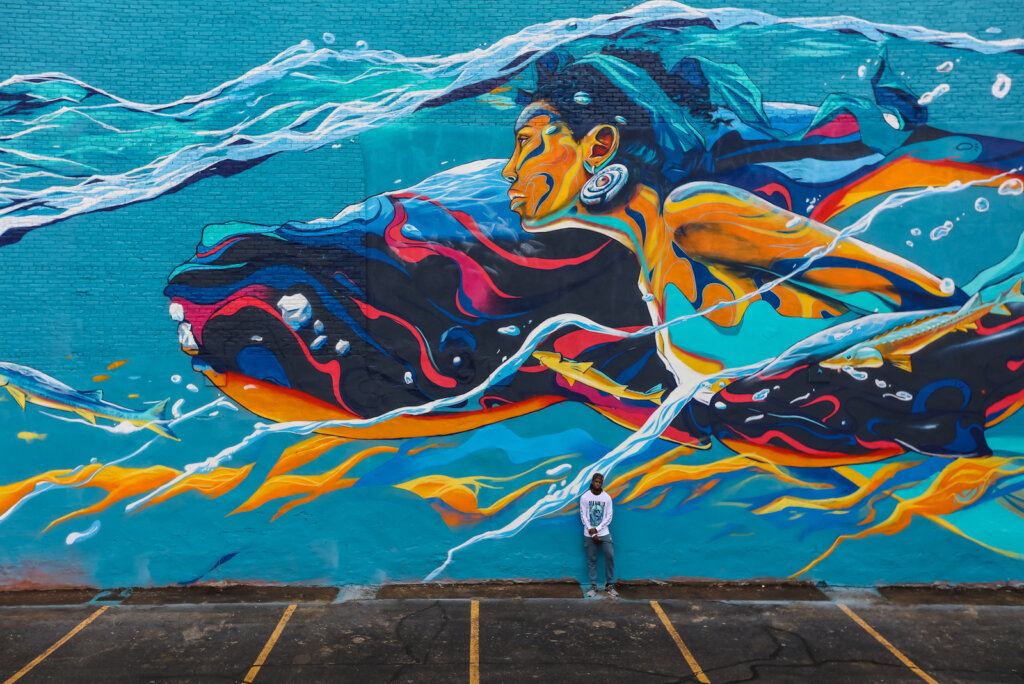
“My goal for this mural was to convey a sense of movement and urgency with the use of vibrancy and beauty. Oftentimes in nature, some of the most beautiful and bright things signal a warning, a caution or some form of call to action. I wanted to create a similar feeling with this piece, drawing in the viewers attention and curiosity to understand a more urgent message. Focusing on the Warming Seas and the critically endangered Right Whale, I wanted to create the feeling of a narrative, with a reference to a sort of hieroglyphic imagery. Something depicting the story of an escape and the immediacy many species face within the ocean. Depicted alongside that, a sort of mythical sea goddess that acts as a guiding figure, something viewers can further relate to and see themselves reflected in, as protectors of the sea. This of course is not just a story, but a reality faced by these majestic creatures. My hope is that this mural sparks some insight and inspiration in those that come across it, to be keepers of the ocean and their environment.”
Taj Francis
Tallboy-Death to Plastic
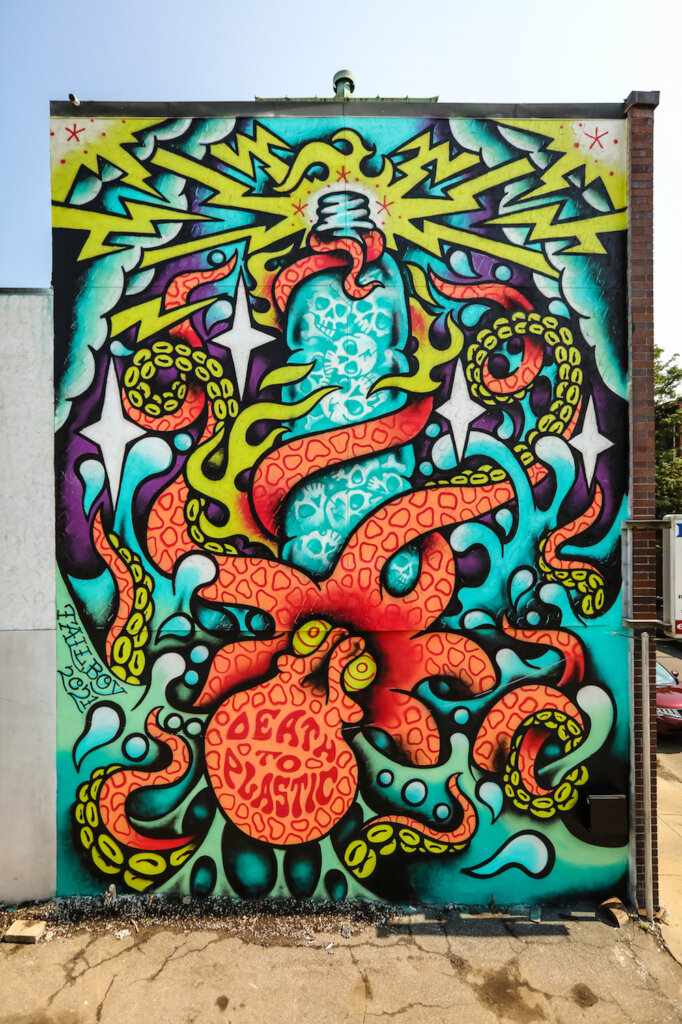
“I think everyone can agree that plastic waste does not belong in our oceans. So why do we have a massive ‘trash island’ floating in the Pacific? Or tropical beaches in Southeast Asia completely littered with garbage?As an artist, the least I can do is paint a wall in my home city of Boston to make people think about this issue more. In my piece Death to Plastic, a giant Octopus rises out of a raging sea, strangling and squeezing a large plastic bottle as it gets struck by lightning and set on fire. The plastic bottle stands tall and mostly unharmed because this material does not break down, which is why we have large masses forming in the ocean. The plastic bottle is also full of human skulls, symbolizing the environmental impact of this problem and how it affects humans as well as aquatic life. As one local told me, ’Those are the skulls of the community if we don’t fix this problem’.”
Tallboy
It’s a Living -Protect What You Love
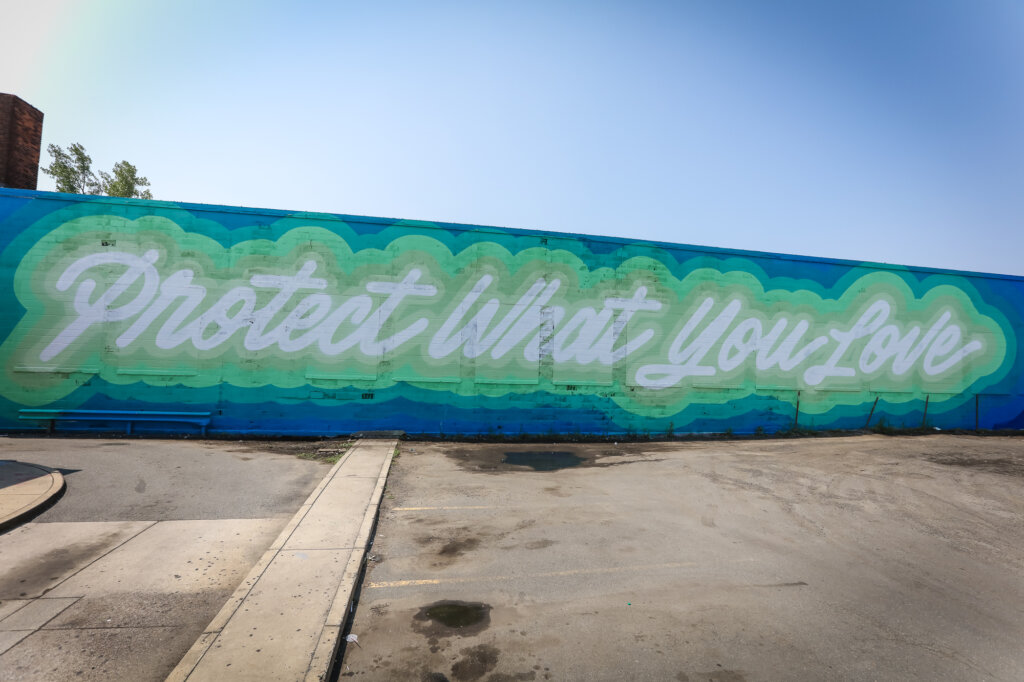
“It is very important to understand that the sea levels are rising at an accelerating rate due to global warming. We should protect our world, the place we live in. Our home and the life in it instead of destroying it. ‘Protect What You Love’ is meant to make a statement on questioning what is valuable to us. The perception on the message is personal, However, this phrase comes from the idea of protecting our world because without it life can not thrive. There are four main causes: Ice melting from land into the ocean, warming waters that expand, a slowing gulf stream, and sinking land. Our planet needs us the most now. Together we can stop this and protect what we love the most: our home.”
It’s a Living
Beau Stanton – Precipice
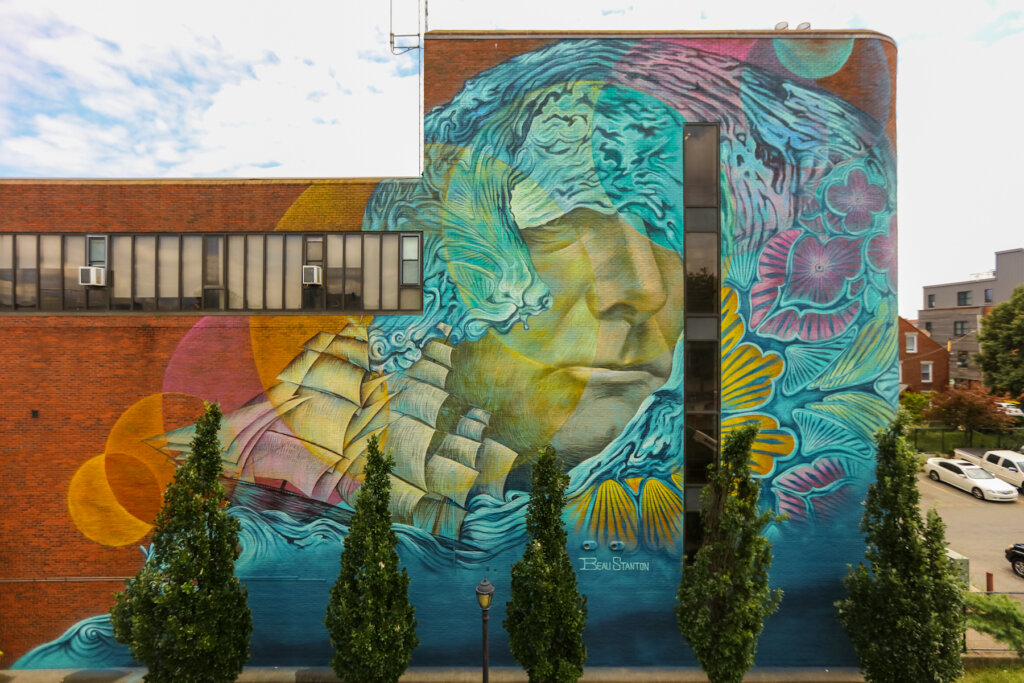
“An illuminated wave crests at the height of the five story East Boston Fire Station partially obscuring a portrait of Donald McKay, a local historic figure who was world renowned for building the fastest ships of the mid 19th century. His most famous vessel, the Flying Cloud, is shown attempting to sail away from the impending threat while being nearly overtaken, suggesting that antiquated solutions cannot provide a way out of the climate crisis.The image reminds us how our collective history is under threat of being washed away while McKay’s still visible right eye suggests our ability to imagine an alternate outcome. Do we have the vision to see our way to a sustainable future or will we all go down with the ship?”
Beau Stanton
Josie Morway – Save Our Space
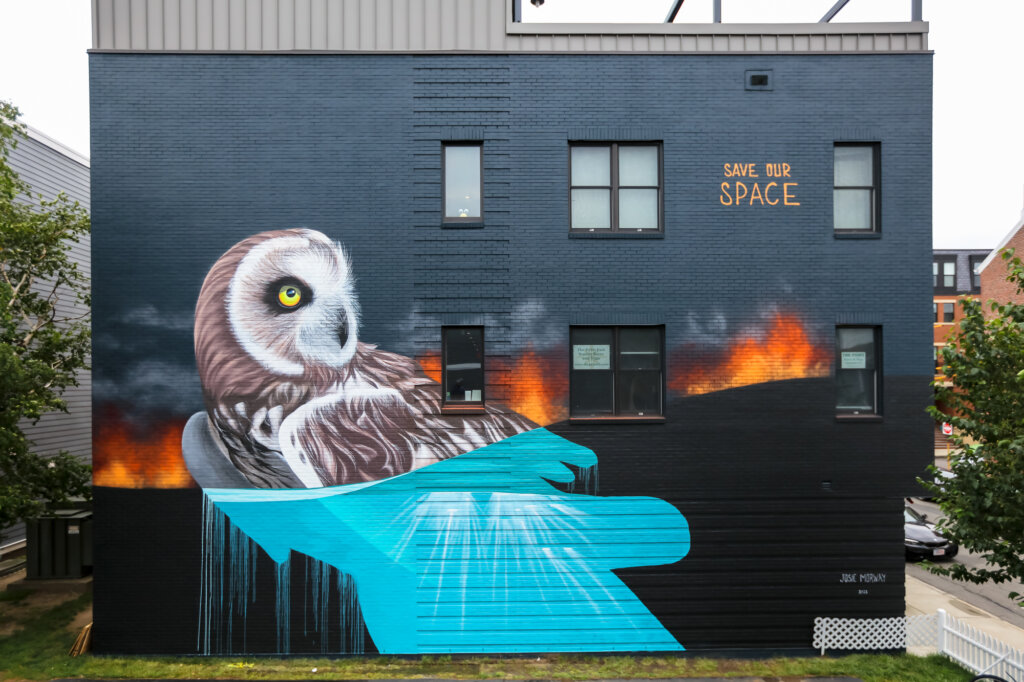
“In my work, I almost always use a cloudy and mysterious background that could be sunset, could be fire, could be something entirely unexpected on the horizon. While painting this mural, I switched my earbuds between music and news on the hour, and was stunned by the constant reporting of extreme weather events happening in real time while I worked. This unavoidable news pushed me to deepen and brighten the ominous horizon behind my short-eared owl, a species native to East Boston and profoundly threatened by the loss of its coastal grassland habitat. And yet… despite the threats to our oceans and coasts, I always invest the creatures in my work with an almost magical level of resilience and hopeful optimism, in this case symbolized by the fresh, clear spirit of a clean ocean wave at the heart of the owl. I hope that my reverence for wildlife shows in my attention to detail, and inspires others to pay this same close attention to the threats on our collective horizon, but also to the great possibilities for change, conservation and abundance that remain if we work together.”
Josie Morway
Photo Credit Sea Walls
